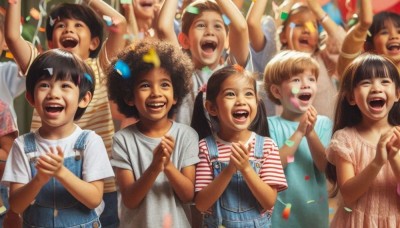- Wow Moment Notes: Documenting children’s “wow moments” in their learning journeys can create a strong link between home and school. These notes highlight significant achievements and can be shared with parents to celebrate together.
- Positive Reinforcement: Simple words of praise and positive body language, like getting down to a child’s level and using a thumbs-up, can significantly boost their confidence.
- Rewards: Visual rewards such as stickers or allowing a child to take a special toy home can be very effective. These tangible rewards help children feel proud of their accomplishments.
- Special Recognition: Providing certificates for specific achievements, like riding a bike without training wheels, can make children feel special and recognized.
- Achievement Boards: Creating a board with photos and captions of children’s achievements can be a great way for them to reflect on their progress and feel proud of their accomplishments.
Creative Ways To Celebrate Children’s Achievements
- Achievement Jars: Create a jar where children can add a bead or a small token each time they achieve something. Watching the jar fill up can be a visual and tangible way to celebrate progress.
- Achievement Wall: Dedicate a wall in your classroom to display children’s work and achievements. You can rotate the displays regularly to keep it fresh and exciting.
- Story Time Celebrations: Incorporate achievements into story time by creating a story where the child is the hero. This can be a fun and engaging way to celebrate their accomplishments.
- Achievement Badges: Design and print custom badges for different achievements. Children can wear these badges proudly, and it can be a great conversation starter with peers and parents.
- Celebration Dance: Have a special dance or song that you play whenever a child achieves something significant. This can create a joyful and memorable moment for the child.
- Parent Involvement: Invite parents to join in the celebration by having a special “achievement day” where parents can come and see their child’s accomplishments. This can strengthen the home-school connection.
- Achievement Books: Create a book for each child where you document their achievements with photos and captions. This can be a wonderful keepsake for them to look back on.
- Classroom Awards Ceremony: Host a mini awards ceremony where each child receives a certificate or a small trophy for their achievements. This can be a fun and formal way to recognize their hard work.
- Achievement Bracelets: Give out colorful bracelets for different achievements. Children can collect and wear these bracelets, which can be a fun way to show off their accomplishments.
- Personalized Messages: Write personalized notes or letters to the children, highlighting their achievements and how proud you are of them. These can be sent home or read aloud in class.
Involving Children In Planning Their Own Celebrations
- Brainstorming Sessions: Hold group discussions where children can share their ideas on how they would like to celebrate. This can be done during circle time or a dedicated planning session.
- Choice Boards: Create a choice board with different celebration options (e.g., dance party, craft activity, special snack). Children can vote on their preferred way to celebrate.
- Role Assignments: Give children specific roles in the planning process, such as decorating, choosing music, or helping to prepare snacks. This gives them a sense of ownership and responsibility.
- Suggestion Box: Set up a suggestion box where children can drop their ideas for celebrations. Review these suggestions together and decide on the best ones.
- Visual Planning: Use visual aids like charts or posters to help children understand the planning process. They can add their ideas and see how the celebration will come together.
- Theme Selection: Let children choose a theme for the celebration. This could be based on their interests, such as a favorite book, animal, or color.
- Collaborative Art Projects: Involve children in creating decorations for the celebration. This could include making banners, posters, or other crafts that reflect their achievements.
- Storytelling: Encourage children to share stories about their achievements and how they would like to celebrate them. This can be a great way to personalize the celebration.
- Feedback Loop: After the celebration, ask children for feedback on what they enjoyed and what they would like to do differently next time. This helps them feel heard and valued.
- Interactive Planning Tools: Use interactive tools like digital whiteboards or apps where children can contribute their ideas and see the planning process in real-time.
What If A Child's Idea Is Not Feasible
- Acknowledge the Idea: Start by acknowledging the child’s idea and showing appreciation for their creativity. For example, “That’s a really interesting idea, and I love how creative you are!”
- Explain the Constraints: Gently explain why the idea might not be feasible. Use simple language and be honest about the limitations. For example, “We might not be able to do that because we don’t have enough space/time/materials.”
- Offer Alternatives: Suggest alternative ideas that are more feasible but still align with the child’s interests. For example, “We can’t have a petting zoo in the classroom, but how about we visit a local farm instead?”
- Involve Them in Problem-Solving: Encourage the child to think of other ways to achieve a similar outcome. Ask questions like, “What else could we do that would be just as fun?”
- Compromise: Find a middle ground where part of the child’s idea can be incorporated. For example, if a child wants a big party, you could have a smaller celebration with some of the elements they suggested.
- Empathy and Encouragement: Show empathy and encourage the child to keep sharing their ideas. For example, “I know it’s disappointing that we can’t do exactly what you wanted, but I really appreciate your great ideas. Let’s keep thinking of fun things we can do together.”
- Follow-Up: After the celebration, revisit the child’s idea and discuss how the alternative worked out. This helps them feel heard and valued, even if their original idea wasn’t possible.
What If A Child Is Hesitant To Participate In Celebrations
- Understand the Hesitation: Try to understand why the child is hesitant. It could be due to shyness, fear of attention, or past experiences. Having a quiet conversation with the child can provide insights.
- Offer Choices: Give the child options on how they can participate. For example, they might prefer to help with preparations rather than being the center of attention.
- Small Group Celebrations: Instead of large group celebrations, consider smaller, more intimate gatherings where the child might feel more comfortable.
- Role Models: Pair the hesitant child with a buddy who is more confident. Seeing their peers participate can sometimes encourage them to join in.
- Gradual Involvement: Gradually involve the child in celebrations. Start with small roles and slowly increase their participation as they become more comfortable.
- Positive Reinforcement: Praise the child for any level of participation, no matter how small. Positive reinforcement can build their confidence over time.
- Respect Their Wishes: If a child truly does not want to participate, respect their wishes. Forcing participation can lead to increased anxiety and discomfort.
- Alternative Activities: Provide alternative activities for the child during celebrations. This ensures they still feel included and engaged, even if they are not directly participating in the main event.
- Parental Involvement: Involve parents in the process. They can provide additional support and encouragement, and their presence might make the child feel more secure.
- Create a Safe Environment: Ensure that the celebration environment is welcoming and non-threatening. Sometimes, a change in setting or approach can make a big difference.
Involving Parents In Celebrating Children's Achievements
Involving parents in discussions about celebrating children’s achievements can strengthen the home-school connection and create a more supportive environment for the children. Here are some ways to engage parents:
- Parent Meetings: Organize regular meetings or workshops where parents can share their ideas and learn about the importance of celebrating achievements. This can be done in person or virtually.
- Surveys and Questionnaires: Send out surveys or questionnaires to gather parents’ input on how they would like to see their children’s achievements celebrated. This can provide valuable insights and make parents feel involved.
- Parent-Teacher Conferences: Use parent-teacher conferences as an opportunity to discuss how achievements are celebrated and how parents can contribute. This can be a great time to align on goals and expectations.
- Classroom Newsletters: Include a section in your classroom newsletter dedicated to celebrating achievements and inviting parents to share their ideas and feedback.
- Volunteer Opportunities: Invite parents to volunteer for celebration events. They can help with planning, decorating, or even leading activities. This hands-on involvement can be very rewarding for both parents and children.
- Home-School Projects: Create projects that involve both parents and children, such as making a scrapbook of achievements or preparing a special presentation. This encourages parents to actively participate in their child’s learning journey.
- Parent Committees: Form a parent committee focused on planning and organizing celebrations. This gives parents a formal role and ensures their voices are heard.
- Digital Platforms: Use digital platforms like class websites, apps, or social media groups to communicate with parents and gather their input. This can be especially useful for busy parents who may not be able to attend in-person meetings.
- Celebration Days: Host special celebration days where parents are invited to join the class and participate in the festivities. This can include performances, award ceremonies, or interactive activities.
- Feedback Loop: After celebrations, ask parents for feedback on what worked well and what could be improved. This continuous feedback loop helps refine the process and keeps parents engaged.
Linking To The EYLF
- Sense of Identity (Outcome 1):
- Celebrating achievements helps children develop a strong sense of identity. When children feel recognized and valued for their efforts, they build confidence and self-esteem1.
- Activities like sharing achievements with peers and families, or displaying children’s work, help them feel a sense of belonging and pride in their accomplishments1.
- Connectedness and Contribution (Outcome 2):
- Recognizing children’s achievements fosters a sense of community and connectedness. It encourages children to contribute to their environment and understand their role within it1.
- Celebrations can include collaborative projects where children work together and celebrate their collective success1.
- Wellbeing (Outcome 3):
- Celebrating milestones supports children’s emotional wellbeing by providing positive reinforcement and encouragement1.
- It helps children develop resilience as they learn to appreciate their efforts and understand that achievements are a result of perseverance and hard work1.
- Learning and Thinking (Outcome 4):
- Acknowledging achievements encourages a love for learning and curiosity. It motivates children to explore, experiment, and engage in new experiences1.
- Celebrations can be linked to specific learning goals, helping children see the connection between their efforts and outcomes1.
- Communication (Outcome 5):
- Celebrating achievements provides opportunities for children to express themselves and share their experiences with others1.
- Activities like storytelling, presentations, or creating achievement books help children develop their communication skills and confidence in expressing their ideas1.
Further Reading
EYLF Outcomes And Children Achievements Posters
How Children Achieve EYLF Learning Outcomes Version 2.0
Importance of Displaying Children's Artwork
Portfolios In Childcare
Encouraging Phrases for Children in Childcare
Using Open Ended Questions with Children
References:
Exploring Celebrations In Children's Services, ACECQA
Ways To Celebrate Children's Achievements, Early Years Careers
Celebrating Milestones, Jan Peterson
Importance Of Celebrating Milestones, Collab For Children







 As an Educator in Australia, your pay rate falls under the Children’s Services Award 2010. This award states the minimum amount that an employer can
As an Educator in Australia, your pay rate falls under the Children’s Services Award 2010. This award states the minimum amount that an employer can When working as a qualified Early Childhood Teacher (with a university degree) within a service, your rate of pay will come from the Educational Services
When working as a qualified Early Childhood Teacher (with a university degree) within a service, your rate of pay will come from the Educational Services When working as a Diploma Qualified Educator your pay rate is from the Children's Services Award 2010. This Award states your minimum rate of pay
When working as a Diploma Qualified Educator your pay rate is from the Children's Services Award 2010. This Award states your minimum rate of pay When working as a Cert 3 Qualified Educator, your pay rate is from the Children's Services Award 2010. This Award states your minimum rate of
When working as a Cert 3 Qualified Educator, your pay rate is from the Children's Services Award 2010. This Award states your minimum rate of Educational Leaders play a crucial role in their early childhood service by ensuring that the educational program aligns with best practices and supports the holistic
Educational Leaders play a crucial role in their early childhood service by ensuring that the educational program aligns with best practices and supports the holistic In early childhood education and care, ratios are more than a technicality—they are a frontline safeguard. Every child deserves responsive supervision, emotional connection, and developmental
In early childhood education and care, ratios are more than a technicality—they are a frontline safeguard. Every child deserves responsive supervision, emotional connection, and developmental With the new national child safety reforms kicking in on 1 September 2025, early childhood services like yours have a real opportunity to lead the
With the new national child safety reforms kicking in on 1 September 2025, early childhood services like yours have a real opportunity to lead the Here’s a comprehensive Mobile Phone and Smart Watch Policy tailored for early childhood education and care (ECEC) services in Australia, aligned with the latest 2025
Here’s a comprehensive Mobile Phone and Smart Watch Policy tailored for early childhood education and care (ECEC) services in Australia, aligned with the latest 2025 The Sea of Fish Challenge is a national initiative that invites children, educators, families, and communities to create and display fish artworks as a symbol
The Sea of Fish Challenge is a national initiative that invites children, educators, families, and communities to create and display fish artworks as a symbol Across the early childhood education and care sector, educators are sounding the alarm: current staffing ratios are insufficient to deliver safe, meaningful, and developmentally appropriate
Across the early childhood education and care sector, educators are sounding the alarm: current staffing ratios are insufficient to deliver safe, meaningful, and developmentally appropriate


